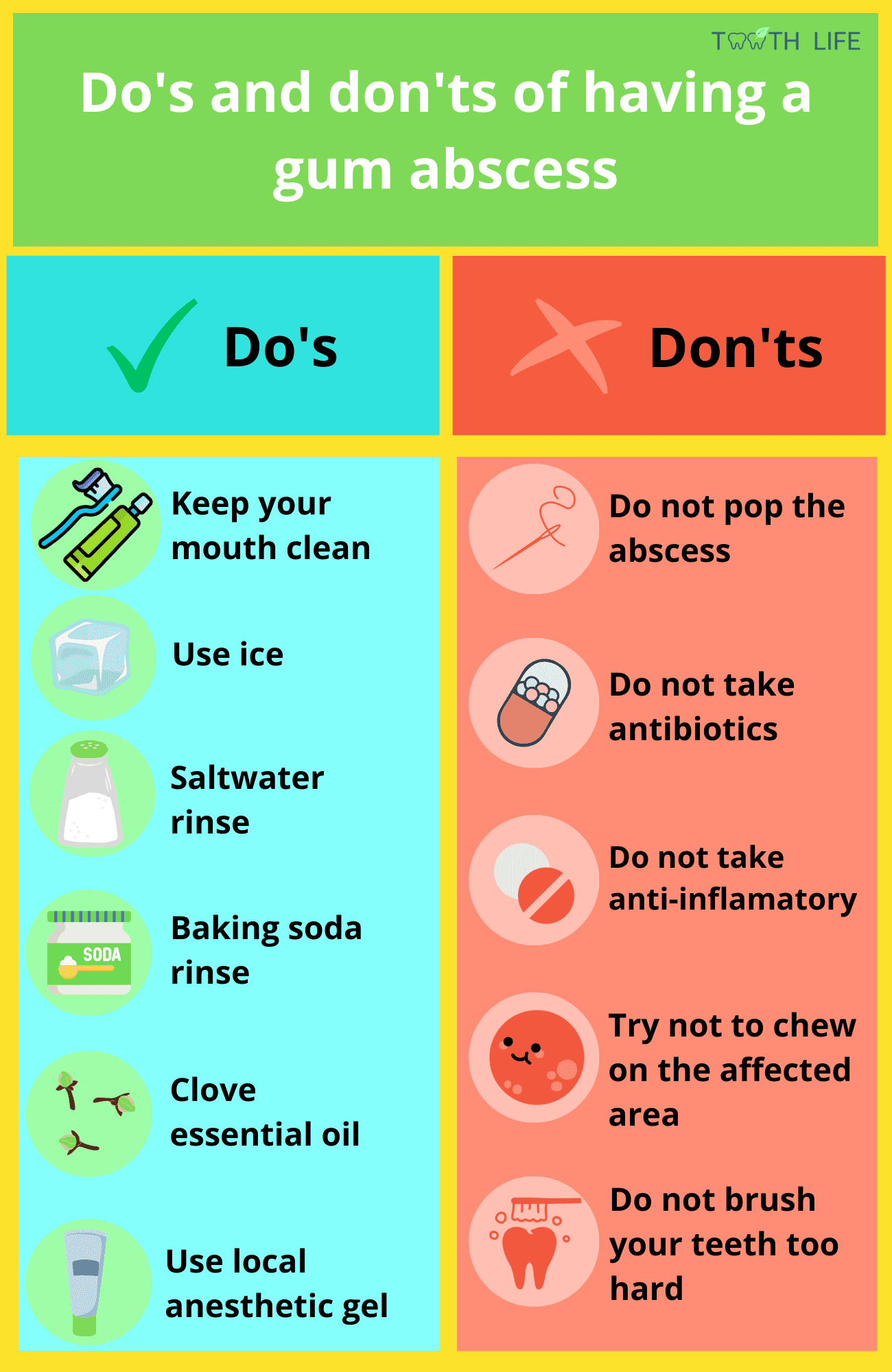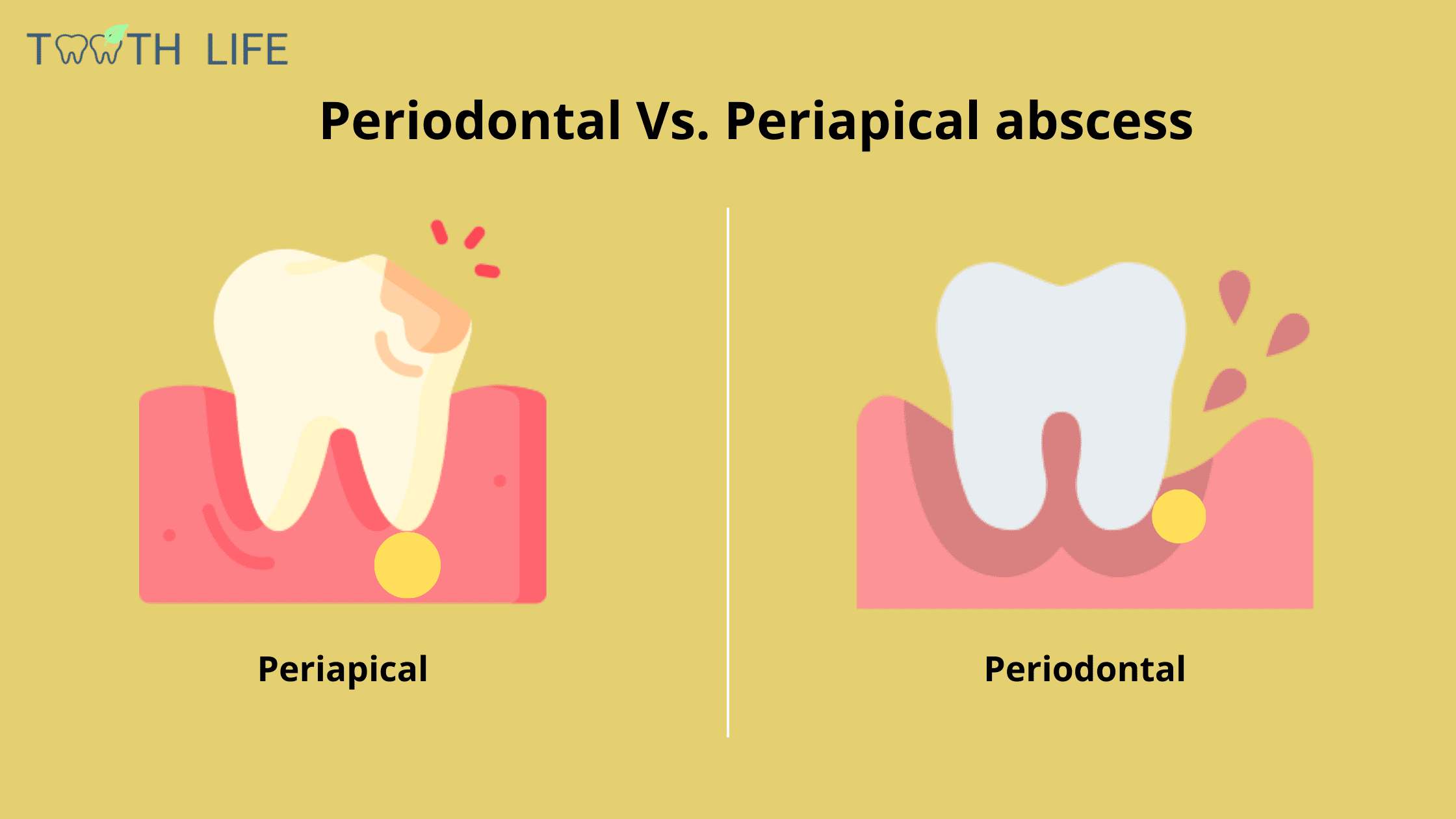Gum Abscess Drainage at Home: Dos and Don'ts for Pain Relief

A gum abscess is typically the result of a severe tooth infection. When bacteria thrive, they damage the nerves and blood vessels that feed your tooth, causing it to die.
Without a living tooth to contain the infection, it spreads into the surrounding jawbone and gums, causing a painful swelling known as a gum abscess or gum boil.
This swelling is just one sign of an underlying tooth infection. When dealing with a gum abscess, the most important thing is to address the root cause of the infection, not just the symptoms.
While draining the abscess may provide temporary relief, it doesn’t solve the underlying issue.
In this article, we’ll dive deeper into gum abscesses, explore the dos and don’ts of home care, and discuss the best ways to treat it effectively.
Without a living tooth to contain the infection, it spreads into the surrounding jawbone and gums, causing a painful swelling known as a gum abscess or gum boil.
This swelling is just one sign of an underlying tooth infection. When dealing with a gum abscess, the most important thing is to address the root cause of the infection, not just the symptoms.
While draining the abscess may provide temporary relief, it doesn’t solve the underlying issue.
In this article, we’ll dive deeper into gum abscesses, explore the dos and don’ts of home care, and discuss the best ways to treat it effectively.
In this article...
1. What Is a Gum Abscess?
2. Can a Gum Abscess Heal on Its Own?
3. Do's for Gum Abscess Relief at Home
4. Don'ts for Gum Abscess Relief at Home
5. My Gum Abscess Went Away by Itself. Did it heal?
6. Potential complications of an untreated gum abscess
7. How Dentists Treat Gum Abscesses the Right Way
What Is a Gum Abscess?
A gum abscess is a pocket of pus caused by a tooth or gum infection. It forms as the body tries to fight off invading bacteria.There are two common ways this can happen:
- Infection of the tooth nerves: This is the most common cause. Bacteria enter the pulp—the soft inner part of the tooth that contains nerves and blood vessels—through a cavity or crack, causing the tooth to die and the infection to spread.
- Infection of the supporting gum and bone: This usually happens with advanced gum disease. When harmful bacteria penetrate the gums and reach the bone that holds your teeth in place, they can cause a serious infection and lead to pus buildup and abscess formation.

No matter where the infection starts, the symptoms are often the same: swelling, redness, pain, and bad breath.
When the infection becomes severe, it can trigger more serious warning signs such as fever, fatigue, swollen lymph nodes, difficulty breathing, or trouble opening the mouth. These are red flags that require urgent medical attention.
Can a Gum Abscess Heal on Its Own?
The short answer is no. Again, a gum abscess is just a symptom of a deeper infection—whether it's in the tooth, gum, or bone. As long as the underlying cause isn’t treated, the abscess won’t go away on its own.When a gum abscess forms, your body will do its best to fight the infection and prevent it from spreading. However, the bacteria will persist as long as the source of infection isn't addressed.
In the case of a tooth infection, a single infected root canal can hold millions of bacteria from different species. Over time, these will eventually overwhelm the immune system.
The only effective way to get rid of the invading bacteria and heal the abscess is by disinfecting and sealing the root canals through root canal treatment.
Do's for Gum Abscess Relief at Home
If you have a gum abscess, the first and most important step is to schedule an appointment with your dentist as soon as possible. While waiting for professional care, there are a few safe things you can do at home to ease the pain and reduce inflammation:Maintain good oral hygiene
Keep brushing and flossing gently, especially around the affected area. This helps reduce the number of bacteria in your mouth and prevents food debris and plaque from building up, which can make the infection worse.Apply ice to the painful area
Applying a cold compress can help reduce pain and swelling. Wrap an ice pack or a bag of frozen vegetables in a towel and hold it against your cheek near the abscess for 10 to 20 minutes at a time.Baking soda rinse
Mix one tablespoon of baking soda in a glass of warm water and rinse your mouth several times a day. Baking soda neutralizes acids and reduces inflammation, which can be refreshing and soothing.Saltwater rinse
Mix one teaspoon of salt in a cup of warm water. You can also add baking soda to make the mixture even more effective.Hydrogen Peroxide Rinse
Hydrogen peroxide is a powerful antiseptic that can quickly kill harmful bacteria. To make the rinse, mix equal parts of 3% hydrogen peroxide and water. Swish it around your mouth for about 30 seconds, then spit it out (do not swallow).Clove essential oil
Clove oil has natural antibacterial and anti-inflammatory properties that can relieve pain. Dab a small amount onto a cotton swab and gently apply it to the affected area for a few minutes.Local anesthetic gel
Over-the-counter numbing gels can be applied directly to the swollen gum to temporarily relieve pain. Always follow the instructions on the label.Don'ts for Gum Abscess Relief at Home
Here are the most common mistakes to avoid when dealing with a gum abscess:Trying to pierce or drain the abscess yourself
This might be tempting, but it's one of the worst things you can do. Trying to pop or drain the abscess at home can not only be painful—it can also spread the infection further. Even if the swelling goes down temporarily, it will likely come back in a few days.It's safer to leave drainage to your dentist who can treat the actual source of the infection.
Taking anti-inflammatory medications
Drugs like ibuprofen and aspirin are often recommended for dental pain because they reduce inflammation. But, in the case of a dental abscess or any other infection, inflammation is actually your body’s natural defense mechanism.Since these medications work by suppressing inflammation, they may ease the pain but can also allow bacteria to spread more easily.
Some studies have even found that using anti-inflammatory drugs during dental infections may increase the risk of delayed treatments and severe complications.
Why? Because they often mask symptoms, allowing the infection to spread silently, without your notice.
It’s safer and just as effective to take other painkillers that don’t interfere with inflammation, such as acetaminophen (Tylenol or Panadol).
Taking antibiotics on your own
Antibiotics alone don’t work for dental abscesses—especially without proper dental treatment. Misusing them can also lead to antibiotic resistance, making future infections harder to treat. Always consult your dentist before taking any antibiotics.Chewing on the affected side
Chewing where the abscess is can increase pressure, pain, and the risk of the abscess popping, which can lead to a foul taste and breath. Try to eat on the opposite side until you get treatment.Brushing or flossing too hard
Maintaining oral hygiene is important, but being too harsh can irritate the area and worsen the pain. Use a soft-bristled toothbrush and brush gently around the affected area.My Gum Abscess Went Away by Itself. Did it heal?
A gum abscess can sometimes seem to disappear on its own, but that doesn’t mean it’s actually healed.This usually happens when your immune system temporarily keeps the infection under control, not because the infection is gone.
There is a constant battle between bacteria and your body’s defenses. When your immune system is winning, the symptoms improve. But when bacteria take over, the infection flares up again, causing swelling, pain, or pus.
What you should remember is that the abscess itself is just a symptom, not the true cause of the infection.
Sometimes, the pain goes away because the abscess drains on its own. This relieves pressure and pain, but again, it doesn’t eliminate the infection that caused it in the first place.
If the root cause isn’t treated, the infection can spread deeper and lead to more serious problems.
Potential complications of an untreated gum abscess
If left untreated, a gum abscess can lead to serious complications, including:- Spread of infection: An untreated gum abscess can cause the infection to spread to other parts of the body, including the jaw, neck, or brain. This can lead to serious health complications, such as meningitis, brain abscess, or sepsis.
- Bacterial endocarditis: Bacteria from gum abscesses can reach the heart through the bloodstream. They can then affect parts of it, leading to potentially fatal heart dysfunction.
- Sepsis: Bacteria reaching the bloodstream can cause a general inflammatory response. People with low immunity, such as diabetics or HIV sufferers, are most at risk of developing this condition. This can lead to vital organ failure and death.
- Tooth loss: As the abscess grows, the bone shrinks and gets weaker. The tooth can then become loose and eventually come out.
- Difficulty eating and speaking: A gum abscess can cause pain and swelling that makes it difficult to eat or speak comfortably. This can affect your quality of life.
- Ludwig's Angina: The infection can spread down the jaws and around the airways. This condition is fatal as it can obstruct breathing and cause death by asphyxiation.
How Dentists Treat Gum Abscesses the Right Way
The specific treatment of a gum abscess depends on the severity and extent of the infection to the surrounding tissue. The first thing to do is to drain the pus to relieve the pressure and give you relief. Next, your dentist will remove the root cause to prevent the abscess from recurring. Here are the basic steps in how your dentist will manage your abscess.1. Drainage of the abscess:
The abscess can be drained in 3 different ways:
Root canal:
The first way to drain a gum abscess is to perform a root canal. Your dentist will make an opening in the tooth and pass fine instruments to the root tip so that the pus flows up, out, and through the tooth. Afterward, your dentist will disinfect and clean your tooth and fill it temporarily.
Gum incision:
If the abscess has not drained properly with root canal treatment, your dentist will make a small incision in the gum to allow the pus to drain out. This will give you immediate relief. Then he will clean and debride the affected area to remove any remaining debris and bacteria.
Tooth extraction:
If the tooth is too damaged or the infection is too severe, the dentist may need to extract the tooth to prevent the infection from spreading.
2. Antibiotics:
Antibiotics are not always necessary. In most cases, drainage is sufficient to heal a gum abscess. However, if the infection is severe, spreading to the surrounding tissue, or if you have a medical condition that weakens your immune system, your dentist may prescribe antibiotics after the drainage to eradicate the infection and bacteria.
3. Follow-up care
Your dentist will schedule follow-up appointments to monitor your progress and recovery and ensure that the infection has been completely cured.